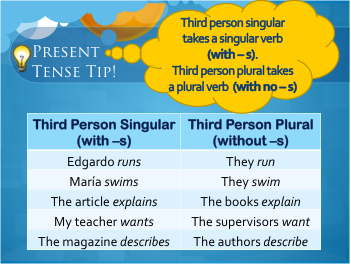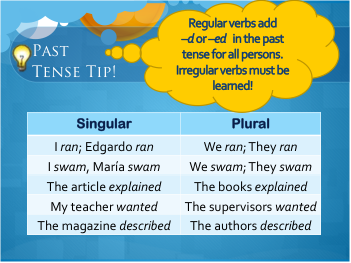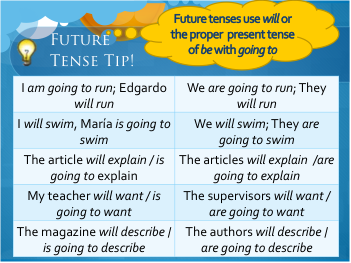| << Chapter < Page | Chapter >> Page > |
Additionally, students should consider whether a verb is regular or irregular. If it is irregular, the verb must be conjugated appropriately based on the following list: Irregular Verb tense list
The instructor should review the present, past, and future simple tense with the students. When reviewing these tenses, the instructor should emphasize that in the present tense, the verb form of a singular subject takes an –s at the end of the verb. A plural subject does not take the –s at the end of the verb.
The instructor should also review the rules to the perfect tense, and highlight that the perfect tense always takes a past participle of the verb.
The following slides provide definitions and tips included in the PowerPoint presentation for Subject-Verb Agreement:
(Slide 2)

(Slide 4)

(Slide 8)

(Slide 12)

The instructor should review all material prior to teaching this lesson. In the slide show, definitions and examples of each of the six tenses are provided. Students should learn to define and discriminate between the correct tenses in each example.
In the PowerPoint presentation, four interactive practice slides (# 5, # 6, # 10, and # 14) offer in-class activities for the instructor to review with the class. Each slide provides individually animated sentences with areas in blank for students to complete. After students respond, with a mouse click, the correct answer appears.
The following general rules to the six tenses are emphasized in the final slides of the PowerPoint presentation (slides # 15, # 16, and #17):
In order to offer this lesson, instructors need a computer and a multi-media projector.
The following materials and handouts are provided with this module:
The authors recommend that the instructor distribute one or both of the practice sheets to the students as a pre-test prior to receiving the lesson. After completing the lesson, students should answer the practice sheets again as a post-test. In this way, instructors may determine whether the students master this objective or require additional instructional support.
References
Hacker, D. (2008). Rules for writers (6th ed.). Boston: Bedford/St. Martin's.
Maimon, E. P., Peritz, J. H.,&Yancey, K. B. (2007). A writer's resource: A handbook for writing and research (2nd ed.). New York: McGraw-Hill.
Walsh, J. M.,&Walsh, A. K. (1972). Plain English handbook (6th ed.). Cincinatti: McCormick-Mathers Publishing Co., Inc.
Willis, D. (1991). Collins cobuild: Student's grammar . London: HarperCollins.

Notification Switch
Would you like to follow the 'Civis project - uprm' conversation and receive update notifications?